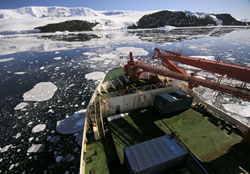Climate change and acid oceans
As power plants, motor vehicles, forest fires, and other anthropogenic and natural sources continue to belch large amounts of carbon dioxide (CO2) into the atmosphere, it remains to be seen what effect this may have on the Earth's oceans. The purpose of NOCES was to use computer-based models to better understand the complex biogeochemical processes involved in air-to-sea transfer of CO2. The Laboratoire des Sciences du Climat et l'Environnement of the Commissariat à l'Énergie Atomique (LSCE/CEA) in France led the NOCES consortium of twelve different research institutes. Using the "business-as-usual" scenario (IS92a) of the Intergovernmental Panel on Climate Change, LSCE/CEA and its partners predicted the expected changes in ocean pH using 13 different models. They found that as atmospheric CO2 concentrations continue to escalate, the dissolution of CO2 in surface waters causes the expected decline in pH; but the corresponding changes in ocean chemistry were more severe in cold waters. Why does this matter? As pH declines, surface waters become less saturated in calcium carbonate (CaCO3) minerals, such as aragonite, making it harder for corals and other marine animals use to build their CaCO3 skeletal or shell material. As the decline continues, the coldest waters actually become corrosive to aragonite by the middle of this century. To illustrate the effect of these changes in marine chemistry on prominent cold-water organisms, these scientists submerged shelled pteropods in seawater altered to have the same corrosive conditions expected for the end of this century. Within 24 hours, there was considerable degradation of their aragonite shells. Analysis of the model output by LSCE/CEA revealed that this acidification will be most prevalent in the Southern Ocean, but will soon spread to the subarctic Pacific Ocean. The NOCES research indicates that these corrosive conditions will be reached within a few decades rather than within centuries as thought previously. A complete review of the modelling work and results has been published in a prominent scientific journal.



